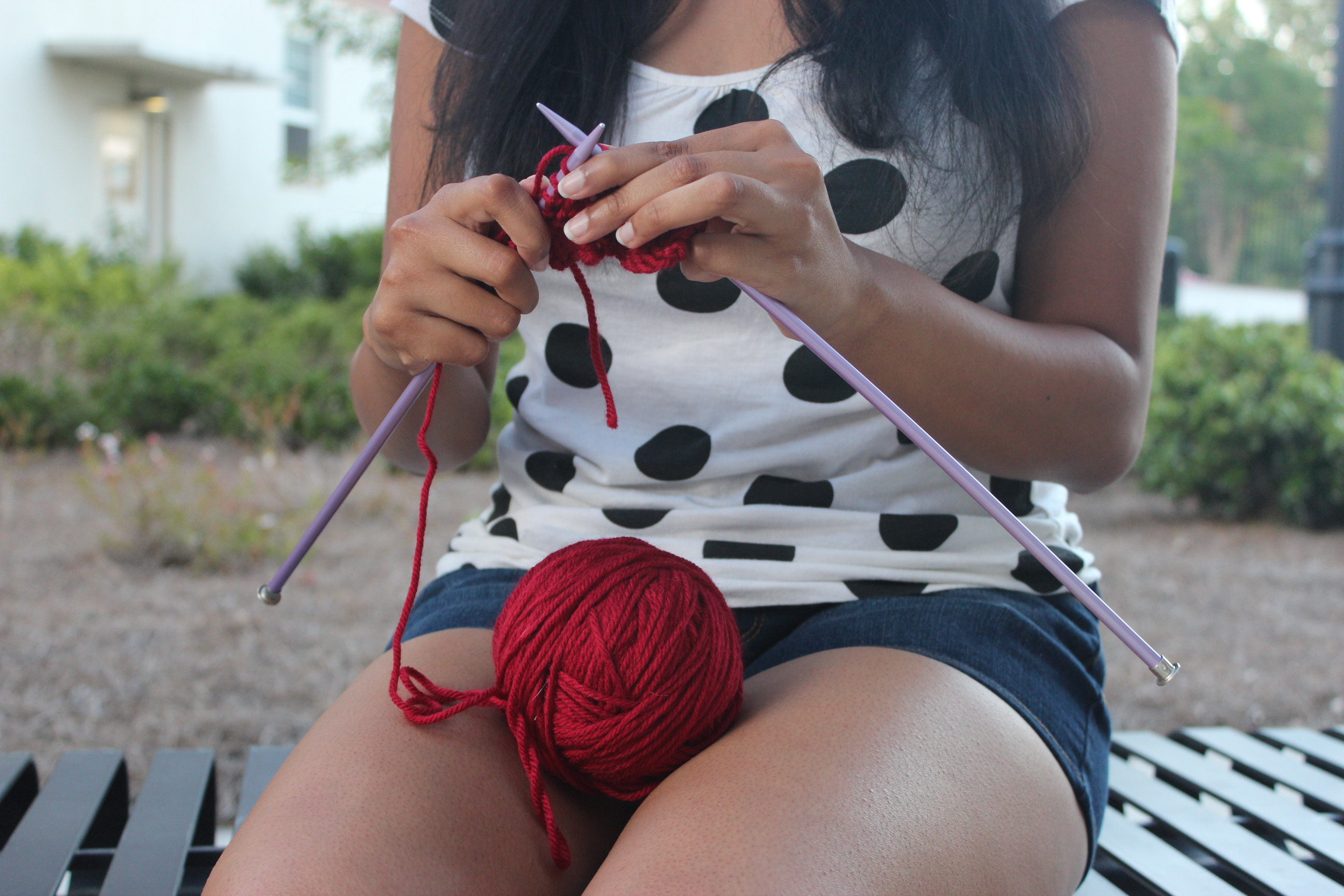Handy Health: The Benefits of Knitting

By Madison Hogan
I started knitting my senior year of high school. It began merely as a curiosity — could I really make a nice hat or scarf on my own? However, the hobby soon became much more than a simple pastime. It was relaxing and enjoyable, and I could practically feel any tension that I had built up flow out of my body as I worked on a soft cowl or a cabled hat. When I focused on my knitting, my project was the only thing that existed. Time flew by as I concentrated solely on my needles, my mind wasn’t frantically jumping from one thought to another, and for once in my life, I wasn’t so tense! Was that a normal response for other knitters, I wondered? Was this a universal feeling among crafters as they created a finished product with their own hands?
 It turns out that, yes, this is completely normal. In fact, knitting and similar activities are shown to be beneficial to one’s mental and emotional health. From calming anxiety and reducing stress to fighting depression and providing a fun, productive coping mechanism, knitting has an incredible array of merits beyond a handmade final product. So how exactly do two needles and some yarn improve someone’s day?
It turns out that, yes, this is completely normal. In fact, knitting and similar activities are shown to be beneficial to one’s mental and emotional health. From calming anxiety and reducing stress to fighting depression and providing a fun, productive coping mechanism, knitting has an incredible array of merits beyond a handmade final product. So how exactly do two needles and some yarn improve someone’s day?
In the past century, creative activities such as knitting have been utilized by mental health professionals as intervention for a variety of behavioral and cognitive conditions. These activities, however, are only one part of the concept of occupation, or the engagement in everyday activities. Humans are occupational creatures and thus depend on involving themselves in activities throughout their lives in order to “maintain health.” It has been shown that occupation has effects including the development of “positive energy, happiness and satisfaction,” all of which are especially helpful when combating disorders such as anxiety or depression.
Activities that evoke flow usually demand ample practice, focus, commitment, and the ability to ignore irrelevant stimuli.
Part of the reason creative activities are so effective when used as intervention is because of their capability to elicit flow. Flow, a concept introduced by psychologist Mihaly Csikszentmihalyi, is a state of being where an individual is completely focused on an activity that they find enjoyable, and as a result, feelings of happiness and satisfaction are achieved as their work flows out of them. The phenomenon has been observed in everyone from composers and poets to athletes and craftspeople. Activities that evoke flow usually demand ample practice, focus, commitment, and the ability to ignore irrelevant stimuli. This is exemplified in hobbies like knitting which require habitual practice to master the techniques; focus is also critical (especially when one is just learning) to ensure that mistakes are not made. Additionally, this focus sometimes requires the knitter to disregard their surroundings, though this is not always necessary. This makes knitting a perfect activity to engage in when seeking to produce flow.
People who experience flow when engaged in an activity are found to be totally immersed in their work and lose focus of the outside world. They also find that they lose track of time and forget any fear or anxiety they might have previously had as they work on their activity. This all results in a satisfied feeling with their work and themselves. Therapists Sharon Gutman and Victoria Schindler suggest that activities that provide the flow experience could be used as a “non-pharmaceutical means to self-regulate emotions such as anger and obsessional phobias.” They also proposed that flow could be used to keep patients from relapsing into depression or from being overwhelmed by their surroundings or “internal chaos.” This would be ideal for those who suffer from anxiety, depression or even eating disorders, since an activity such as knitting could take a one’s mind off his or her constant worries and fears, while giving them something enjoyable to do. This is supported by a study published in The British Journal of Occupational Therapy that showed that 81% of the surveyed knitters with depression reported feeling happier and more relaxed after knitting.
By using a creative activity like knitting, people could stave off phobias and worries that come with anxiety, pervasive sadness brought on by depression and everyday stress.
Knitting has been described as an “alternative meditative process” with “Zen-like” qualities because of the flow experience it induces. Flow itself has been compared to meditation due to a number of similarities between the two practices, such as a focus on the present and the release of worry. Because of its observed effects, therapists suggest that occupation could be used as a “meditative practice to manage stress, anxiety and emotional reactivity.” By using a creative activity like knitting, people could stave off phobias and worries that come with anxiety, pervasive sadness brought on by depression and everyday stress.
Stress, worry, and sadness are all a natural part of life. However, combating these emotions sometimes takes more than a grin-and-bear-it attitude. If an individual can identify an activity that truly evokes happiness and acts as an outlet for focusing on the present, then they can utilize that activity to prevent pervasive negative emotions. Knitting happens to be one such activity that has been shown to produce these effects. So next time finals come around, maybe a pair of needles and some yarn would be the perfect way to wind down.
